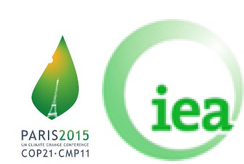In December 2015, 196 Party delegations, plus countless observers, advisers, activists, non-governmental organizations (NGOs) and private companies gathered in Paris, France, to try to agree on a universally-agreeable path to addressing climate change.
But what immediate and direct effect on climate change did the 21st session of the Conference of the Parties to the UNFCCC (COP 21) itself have?
This Mitigation Update includes the recently announced total carbon footprint for the COP 21 event, highlights the role the Clean Development Mechanism (CDM) can have in shaping part of the Paris Agreement implementation and previews the focus on renewables the International Energy Agency (IEA) will have this year.
 13 May 2016: In December 2015, 196 Party delegations, plus countless observers, advisers, activists, non-governmental organizations (NGOs) and private companies gathered in Paris, France, to try to agree on a universally-agreeable path to addressing climate change. But what immediate and direct effect on climate change did the 21st session of the Conference of the Parties to the UNFCCC (COP 21) itself have? This Mitigation Update includes the recently announced total carbon footprint for the COP 21 event, highlights the role the Clean Development Mechanism (CDM) can have in shaping part of the Paris Agreement implementation and previews the focus on renewables the International Energy Agency (IEA) will have this year.
13 May 2016: In December 2015, 196 Party delegations, plus countless observers, advisers, activists, non-governmental organizations (NGOs) and private companies gathered in Paris, France, to try to agree on a universally-agreeable path to addressing climate change. But what immediate and direct effect on climate change did the 21st session of the Conference of the Parties to the UNFCCC (COP 21) itself have? This Mitigation Update includes the recently announced total carbon footprint for the COP 21 event, highlights the role the Clean Development Mechanism (CDM) can have in shaping part of the Paris Agreement implementation and previews the focus on renewables the International Energy Agency (IEA) will have this year.
COP 21’s Carbon Footprint
Forecasts for COP 21 suggested that the event’s carbon cost would total approximately 21,000 tonnes of carbon dioxide equivalent from emissions originating from French territory. On 7 April, the French Presidency announced that its concerted effort to reduce emissions on-site resulted in a final figure of 9,200 tonnes emitted on national territory. To offset these emissions, the French Presidency intends to fund a project in a developing country that reduces emissions. With long-distance travel included, the estimated total emissions for the event are 43,000 tonnes carbon dioxide equivalent. Carbon credits allocated by COP 21 partners will be used to offset the emissions associated with participants’ long-distance travel.
The Presidency also announced that 94% of the 16,000 tonnes of material used to build the 18,000-hectare site has been reused and that it received ISO 20121 certification for the sustainable management of the event, which included environmental, social and economic dimensions. The certification has never before been achieved for the management of an event of this magnitude. [French Presidency Press Release] [French Presidency Press Kit]
Learning from the CDM
The Paris Agreement devotes Article 6 to cooperative approaches, which may include internationally transferred mitigation outcomes as well as non-market approaches. The Article also establishes a mechanism to contribute to the mitigation of greenhouse gas (GHG) emissions and support sustainable development. With many of the rules, modalities and procedures for this mechanism yet to be defined, Parties have the opportunity to learn from the experience of the Clean Development Mechanism (CDM), which was established by the Kyoto Protocol.
UNFCCC Executive Secretary Christiana Figueres highlighted this point at the 89th CDM Executive Board meeting, noting previous experience with carbon markets will be invaluable to future work to implement the Paris Agreement. Since its inception, the CDM has registered 8,000 projects and programmes in more than 105 countries, resulting in the issuance of over 1.6 billion certified emission reductions (CERs). Each CER is a credit equivalent to one tonne of GHG emissions reduced or avoided.
The CDM experience in monitoring, reporting and verification (MRV), results-based financing and fostering transparency and predictability around climate finance instruments will be informative for developing the provisions laid out in Article 6. In addition to reflecting on lessons learned, the Executive Board approved a second methodology for aviation sector projects that reduce emissions from planes parked at airport gates and revised its first aviation methodology for emissions reductions from airplanes as they taxi into position. It also took up, inter alia, governance and management matters and case-specific rulings. The meeting convened from 9-13 May in Bonn, Germany. [UNFCCC Press Release] [CDM Executive Board Meeting Website]
IEA WEO Will Focus on Renewables
In planning their emission-reduction strategies for the energy sector, many governments are informed by the flagship publication of the IEA, the World Energy Outlook (WEO). IEA began gathering input for this year’s WEO at the end of April with over 100 experts gathering at a high-level workshop to discuss how renewables can best limit climate change, foster energy security and mitigate air pollution.
WEO 2016 will include an in-depth feature on challenges and opportunities for deployment of renewables for electricity as well as other uses. According to IEA Executive Director Fatih Birol, while the growing role of renewables in new electricity generation has been clear in recent editions of the WEO, IEA “must go beyond current and proposed policies – we need to advise policymakers on how to massively scale up renewables in order to achieve our common climate and development goals.”
During the workshop, held 29 April in Paris, France, participants analyzed the best policies, measures and investment environment required to accelerate the uptake of renewable energy technologies, working to clarify the key messages that should be highlighted for policymakers. WEO 2016 will be released on 16 November. [IEA Press Release]